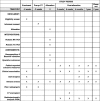A prospective double-blinded randomised control trial comparing robotic arm-assisted functionally aligned total knee arthroplasty versus robotic arm-assisted mechanically aligned total knee arthroplasty
- PMID: 32070406
- PMCID: PMC7027302
- DOI: 10.1186/s13063-020-4123-8
A prospective double-blinded randomised control trial comparing robotic arm-assisted functionally aligned total knee arthroplasty versus robotic arm-assisted mechanically aligned total knee arthroplasty
Abstract
Background: Total knee arthroplasty (TKA) with mechanical alignment (MA) aims to achieve neutral limb alignment in all patients, whereas TKA with functional alignment (FA) aims to restore native, patient-specific anatomy and knee kinematics by manipulating bone resections and fine-tuning implant positioning. The objective of this study is to determine the optimal alignment technique in TKA by comparing patient satisfaction, functional outcomes, implant survivorship, complications, and cost-effectiveness in MA TKA versus FA TKA. Robotic technology will be used to execute the planned implant positioning and limb alignment with high-levels of accuracy in all study patients.
Methods and analysis: This prospective double-blinded randomised control trial will include 100 patients with symptomatic knee osteoarthritis undergoing primary robotic arm-assisted TKA. Following informed consent, patients will be randomised to MA TKA (the control group) or FA TKA (the investigation group) at a ratio of 1:1 using an online random number generator. Blinded observers will review patients at regular intervals for 2 years after surgery to record predefined study outcomes relating to postoperative rehabilitation, clinical progress, functional outcomes, accuracy of implant positioning and limb alignment, gait, implant stability, cost-effectiveness, and complications. A superiority study design will be used to evaluate whether FA TKA provides superior outcomes compared to MA TKA. Primary and secondary objectives will be used to quantify and draw inferences on differences in the efficacy of treatment between the two groups. Intention-to-treat and per-protocol population analysis will be undertaken. The following statistical methods will be employed to analyse the data: descriptive statistics, independent t test, paired t test, analysis of variance, Fisher exact test, chi-square test, and graphical displays. Ethical approval was obtained from the London-Surrey Research Ethics Committee, UK. The study is sponsored by University College London, UK.
Discussion: This is the first study to describe the use of robotic technology to achieve FA TKA, and the only existing clinical trial comparing robotic MA TKA versus robotic FA TKA. The findings of this study will enable an improved understanding of the optimal alignment technique in TKA for achieving high-levels of patient satisfaction, improving functional outcomes, increasing implant survivorship, improving cost-effectiveness, and reducing complications.
Registration: Clinical Trials.gov, NCT04092153. Registered on 17 September 2019.
Conflict of interest statement
FSH reports board membership of
Figures


References
-
- National Joint Registry. 16th Annual Report 2019.https://reports.njrcentre.org.uk/Portals/0/PDFdownloads/NJR%2016th%20Ann.... Date accessed 22 Jan 2020.
Publication types
MeSH terms
Associated data
Grants and funding
LinkOut - more resources
Full Text Sources
Medical

